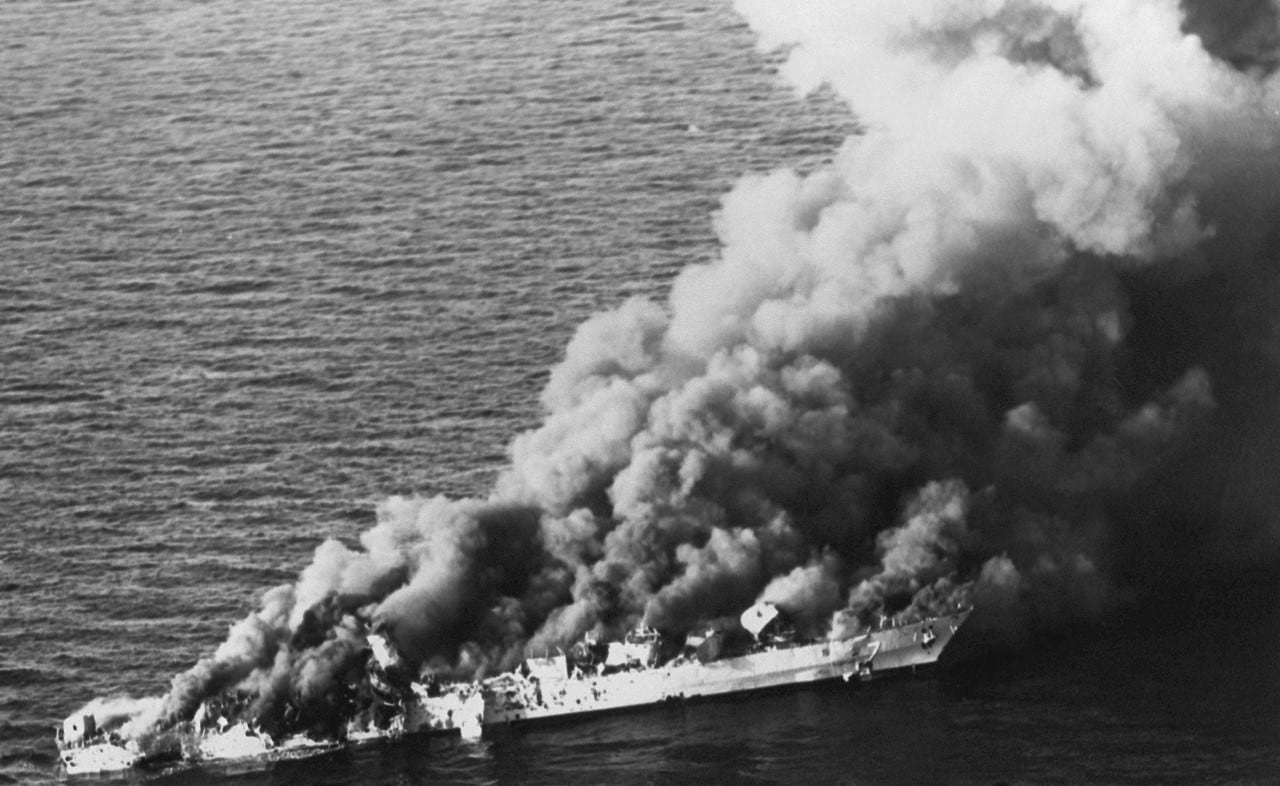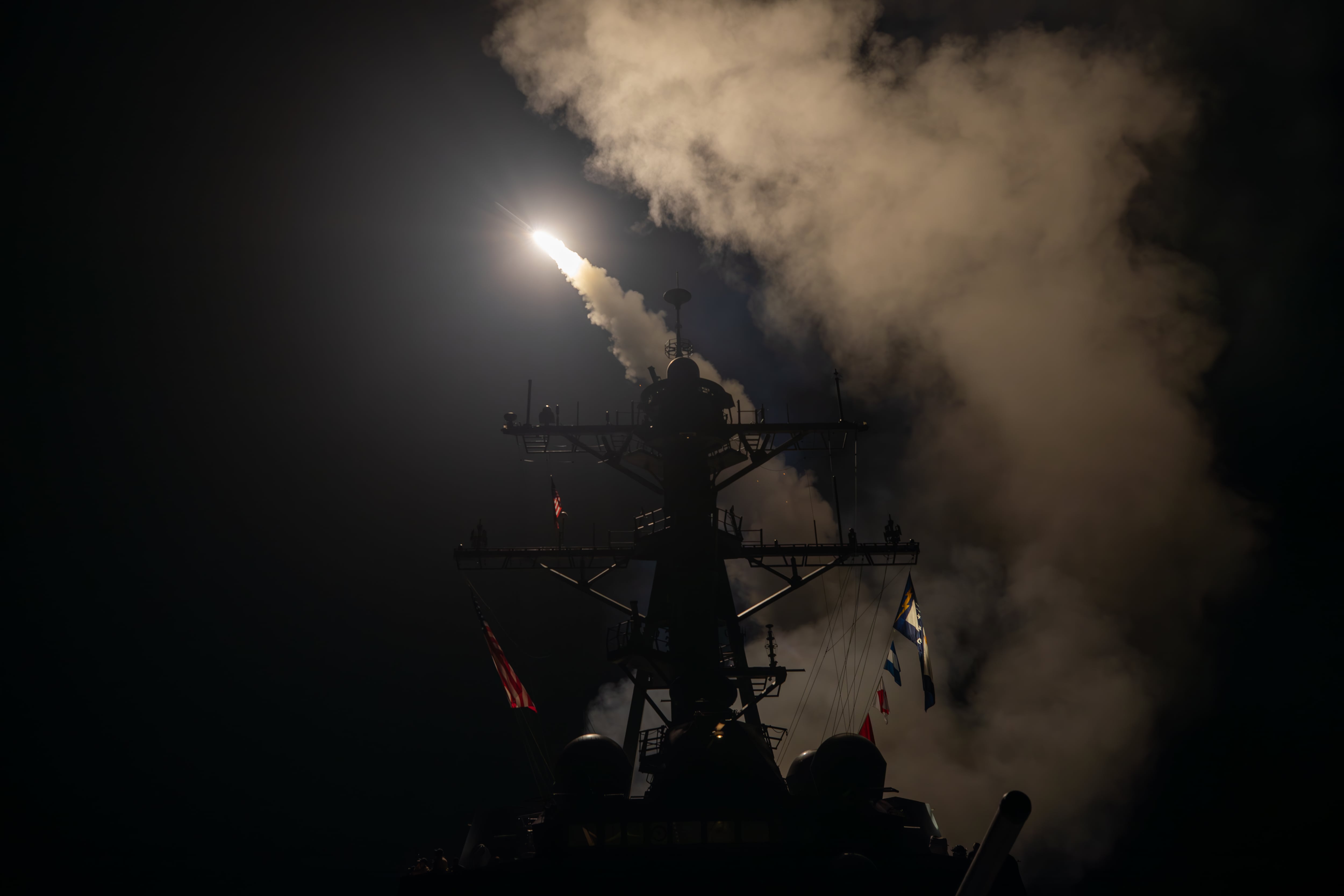While some of the Navy’s ongoing battles in the Red Sea and the Gulf of Aden are without precedent — such as the Iran-backed Houthis’ use of anti-ship ballistic missiles — this is not the first time the sea service has found itself defending commercial vessels in the restive waters of the Middle East.
Decades ago, the so-called “Tanker War” also saw Navy warships protecting commercial shipping in the region, while fending off attacks on those vessels and its own surface fleet.
“It’s the closest historical analogy in my mind that applies to what we’re seeing with the Houthis today,” said Brent Sadler of the Heritage Foundation, who wrote the book “U.S. Naval Power in the 21st Century: A New Strategy for Facing the Chinese and Russian Threat.”
Nearly 40 years later, the Navy once again finds itself navigating an escalating conflict in the region, with both merchant and military ships being targeted by the Yemen-based Houthis.
In response, America is using its military might to ensure that commerce can keep flowing through the Red Sea, a waterway where an estimated 11 percent of global trade transits.
“One of the preeminent national interests of the United States is the free flow of commerce,” retired Vice Adm. Kevin Donegan, a former commander of the Navy’s 5th Fleet in the region, told Navy Times.
But unlike today’s crisis to date, the Tanker War involved stricken U.S. warships and sailor deaths.
In the 1980s, the United States found itself drawn into an extended campaign to protect commercial shipping in the Middle East following a fatal incident involving a Navy frigate.
U.S. involvement effectively began on May 17, 1987, when the Oliver-Hazard Perry class frigate Stark was transiting the Persian Gulf. Two Iraqi Exocet missiles struck the vessel, killing 37 American sailors and wounding another 21.
The tragic incident during the Tanker War, an outgrowth of the broader Iran-Iraq War that was sparked by Iraq’s 1980 invasion of its neighbor, marked the beginning of an American convoy operation to ensure the safety of merchant ships passing in and near the Persian Gulf.
And while today’s engagements with the Houthis at times parallel the Tanker War, analysts and experts say the current conflict also suggests a new level of defensive action for the surface fleet.
The sea service’s continued clashes with the Houthis have put pressure on the Navy to “defend against a lot more systems for a lot longer,” Donegan said.
“It’s certainly a lot of missiles inbound to ships that we haven’t seen in quite some time … where we’ve had to respond to those in a defensive manner,” he said.
“The character of naval warfare changes all the time,” noted James Holmes, a former surface warfare officer and director of maritime strategy at the Naval War College. “But the fundamentals of strife between combatants determined to get their way at sea never do.”
Teachings from the Tanker War
In the fallout of the 1979 Iranian Revolution, and the overthrow of the nation’s American-backed leader, hostility between Iraq and Iran expanded into full-scale war.
By the early 1980s, with the bloody ground combat between the countries at a stalemate, Iraq began attacking Iranian shipping, leading to a new phase of the conflict. Iran retaliated, and global commerce within the sea lanes off the nations’ coasts no longer remained free from interference.
After the Stark attack, which Iraq claimed was an accident, the United States officially commenced Operation Earnest Will in July 1987, escorting Kuwaiti tankers re-flagged as U.S. ships through the troubled waters, according to the Naval History and Heritage Command.
Today, several lawmakers are questioning whether President Joe Biden needs congressional authorization to protect foreign commercial vessels from the Houthis, or to continue launching strikes against the militant group.
But the American military was pulled into the Tanker War for other reasons as well, according to experts.
The U.S. wanted to aid Iraq, leading the Navy to defend oil shipments transiting the Gulf that helped Baghdad secure funding for its fight, according to Dr. Tim Francis, a senior historian with Naval History and Heritage Command.
And amid the Cold War, American leaders also wanted to prevent the Soviet Union from dictating how the escort operation would occur, Sadler said.
A months-long streak of continued engagements between the U.S. and Iran reached a climax in April 1988, when the U.S. frigate Samuel B. Roberts was severely damaged by an Iranian mine. Days later, the U.S. launched Operation Praying Mantis, a retaliatory effort that targeted various Iranian assets.

Even before the Tanker War, the Navy had participated in missions to protect commercial vessels, such as the Yangtze River Patrol of the 1920s that protected merchant ships on the coast and rivers of China, Francis said.
And while the conflict between Iran and Iraq ended in 1988, other 20th-century conflicts also saw a great deal of maritime action, including the Korean War, Vietnam War and the Gulf War, according to Holmes.
“The Houthi war falls more into the same class as our 1980s deployments off Lebanon and Libya, and our post-9/11 support for joint and combined operations,” he said in an email to Military Times.
Broadly speaking, the Navy has learned from modern warfare that warships need to maintain sufficient well-trained watch teams to be able to operate at a certain level around the clock for sustained periods of time, Jan van Tol, a retired Navy captain and senior fellow at the Center for Strategic and Budgetary Assessments, said via email.
“That of course puts a real premium on ships being able to train their watch teams and keep training and qualifying new watch standers both before deploying and also during deployment,” he added. “The real possibility of being hit also once again underlines the critical importance of good damage control training.”
But the real escalation question, van Tol said, is how the U.S. would respond against Iran if a Navy warship is hit and sailors are killed.

Houthi attacks since October
The Houthis launched their campaign against ships in the Middle East in October in solidarity with Hamas after the Palestinian militant group’s attack earlier that month on Israel.
Check out Navy Times’ updated tracker report for up-to-date information regarding the ongoing series of engagements between the U.S. Navy and the Houthis, including a catalog of near-daily clashes between the two sides through February.
The Houthi attacks led the United States to create a multinational security coalition named Operation Prosperity Guardian in December to protect ships transiting the Red Sea and the Gulf of Aden, vital corridors of global commerce.
RELATED

By January, the U.S. State Department announced it would designate the Houthis as a terrorist group and the Department of the Treasury imposed sanctions against key Houthi officials. Earlier that month, a United Nations Security Council resolution demanded the Houthis cease their attacks on vessels and took note of the right of member states to defend from such attacks.
The lion’s share of the weapons and training that the Houthis have built up over the years came from Iran, said Donegan, who also served as director of operations for U.S. Central Command. He added that while the U.S. is slowly taking out the Houthis’ various assets, it needs to better interdict the supply chains from Iran that supply the Houthi insurgents.
In February, a Defense Intelligence Agency report confirmed that Houthi forces have employed various missiles and unmanned aerial vehicles from Iran in their regional attacks. It noted that Iran’s Islamic Revolutionary Guard Corps’ Quds Force has provided the Houthis a growing arsenal of sophisticated weapons and training since 2014.
The U.S. and its partners have intercepted at least 18 Iranian smuggling vessels with illicit weapons on their way to the Houthis since 2015, the DIA report notes.
Some analysts are bracing for a change to Houthi tactics.
Sadler said the Navy should increase field testing of high-energy lasers as a cheaper tool to take down Houthi drones, instead of relying on the expensive and finite high-end missiles that a Navy destroyer carries.
“The next evolutionary challenge for the U.S. Navy in the Red Sea is going to be the Houthis making more coordinated, diversionary attacks in order to wear down a ship’s defenses or distract its defenses in order to get in the attack that they’re planning,” he said.
Jonathan is a staff writer and editor of the Early Bird Brief newsletter for Military Times. Follow him on Twitter @lehrfeld_media





